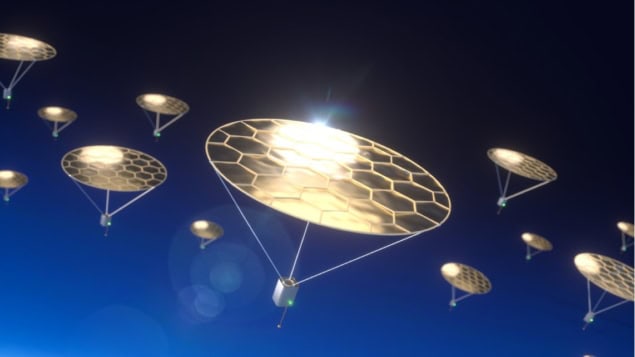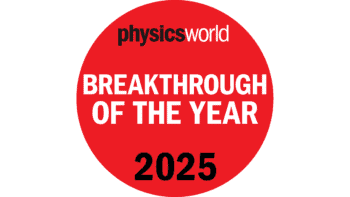
Small levitating platforms that can stay airborne indefinitely at very high altitudes have been developed by researchers in the US and Brazil. Using photophoresis, the devices could be adapted to carry small payloads in the mesosphere where flight is notoriously difficult. It could even be used in the atmospheres of moons and other planets.
Photophoresis occurs when light illuminates one side of a particle, heating it slightly more than the other. The resulting temperature difference in the surrounding gas means that molecules rebound with more energy on the warmer side than the cooler side – producing a tiny but measurable push.
For most of the time since its discovery in the 1870s, the effect was little more than a curiosity. But with more recent advances in nanotechnology, researchers have begun to explore how photophoresis could be put to practical use.
“In 2010, my graduate advisor, David Keith, had previously written a paper that described photophoresis as a way of flying microscopic devices in the atmosphere, and we wanted to see if larger devices could carry useful payloads,” explains Ben Schafer at Harvard University, who led the research. “At the same time, [Igor Bargatin’s group at the University of Pennsylvania] was doing fascinating work on larger devices that generated photophoretic forces.”
Carrying payloads
These studies considered a wide variety of designs: from artificial aerosols, to thin disks with surfaces engineered to boost the effect. Building on this earlier work, Schafer’s team investigated how lightweight photophoretic devices could be optimized to carry payloads in the mesosphere: the atmospheric layer at about 50–80 km above Earth’s surface, where the sparsity of air creates notoriously difficult flight conditions for conventional aircraft or balloons.
“We used these results to fabricate structures that can fly in near-space conditions, namely, under less than the illumination intensity of sunlight and at the same pressures as the mesosphere,” Schafer explains.
The team’s design consists two alumina membranes – each 100 nm thick, and perforated with nanoscale holes. The membranes are positioned a short distance apart, and connected by ligaments. In addition, the bottom membrane is coated with a light-absorbing chromium layer, causing it to heat the surrounding air more than the top layer as it absorbs incoming sunlight.
As a result, air molecules move preferentially from the cooler top side toward the warmer bottom side through the membranes’ perforations: a photophoretic process known as thermal transpiration. This one-directional flow creates a pressure imbalance across the device, generating upward thrust. If this force exceeds the device’s weight, it can levitate and even carry a payload. The team also suggests that the devices could be kept aloft at night using the infrared radiation emitted by Earth into space.
Simulations and experiments
Through a combination of simulations and experiments, Schafer and his colleagues examined how factors such as device size, hole density, and ligament distribution could be tuned to maximize thrust at different mesospheric altitudes – where both pressure and temperature can vary dramatically. They showed that platforms 10 cm in radius could feasibly remain aloft throughout the mesosphere, powered by sunlight at intensities lower than those actually present there.
Based on these results, the team created a feasible design for a photophoretic flyer with a 3 cm radius, capable of carrying a 10 mg payload indefinitely at altitudes of 75 km. With an optimized design, they predict payloads as large as 100 mg could be supported during daylight.
“These payloads could support a lightweight communications payload that could transmit data directly to the ground from the mesosphere,” Schafer explains. “Small structures without payloads could fly for weeks or months without falling out of the mesosphere.”
With this proof of concept, the researchers are now eager to see photophoretic flight tested in real mesospheric conditions. “Because there’s nothing else that can sustainably fly in the mesosphere, we could use these devices to collect ground-breaking atmospheric data to benefit meteorology, perform telecommunications, and predict space weather,” Schafer says.
Requiring no fuel, batteries, or solar panels, the devices would be completely sustainable. And the team’s ambitions go beyond Earth: with the ability to stay aloft in any low-pressure atmosphere with sufficient light, photophoretic flight could also provide a valuable new approach to exploring the atmosphere of Mars.
The research is described in Nature.



